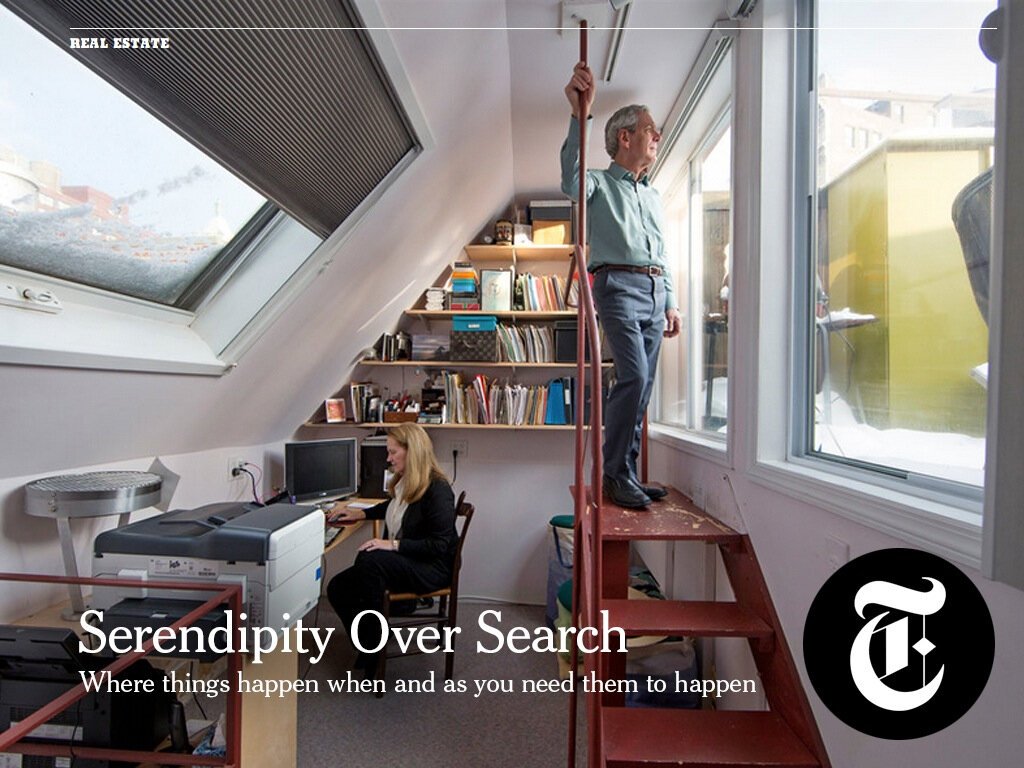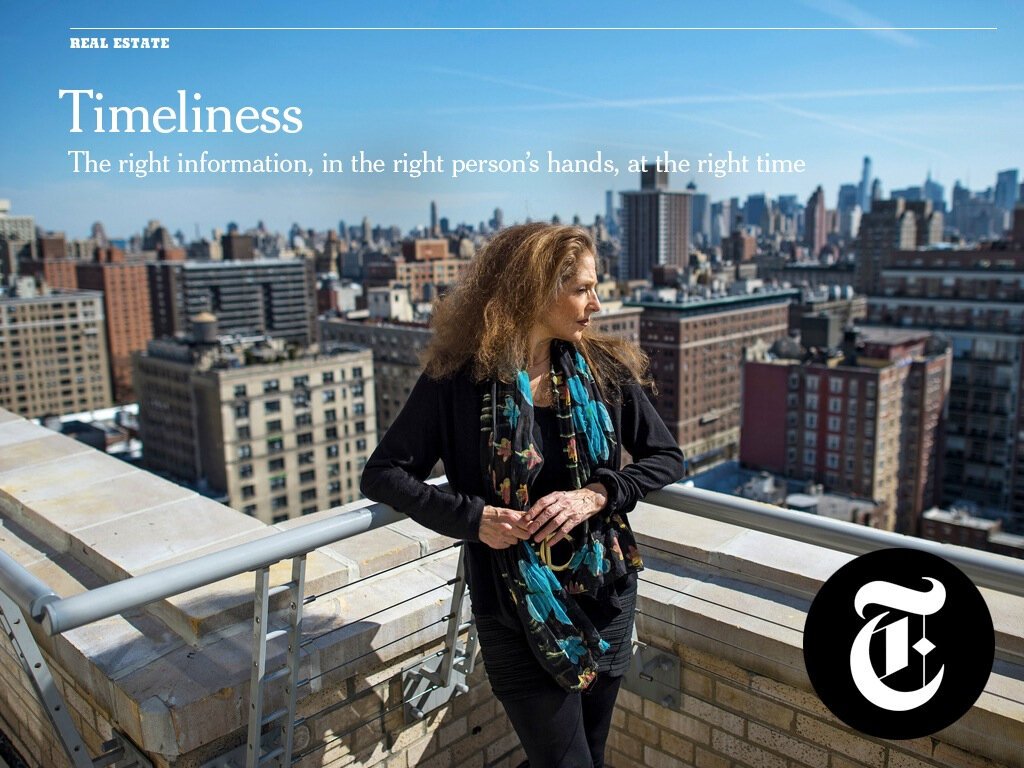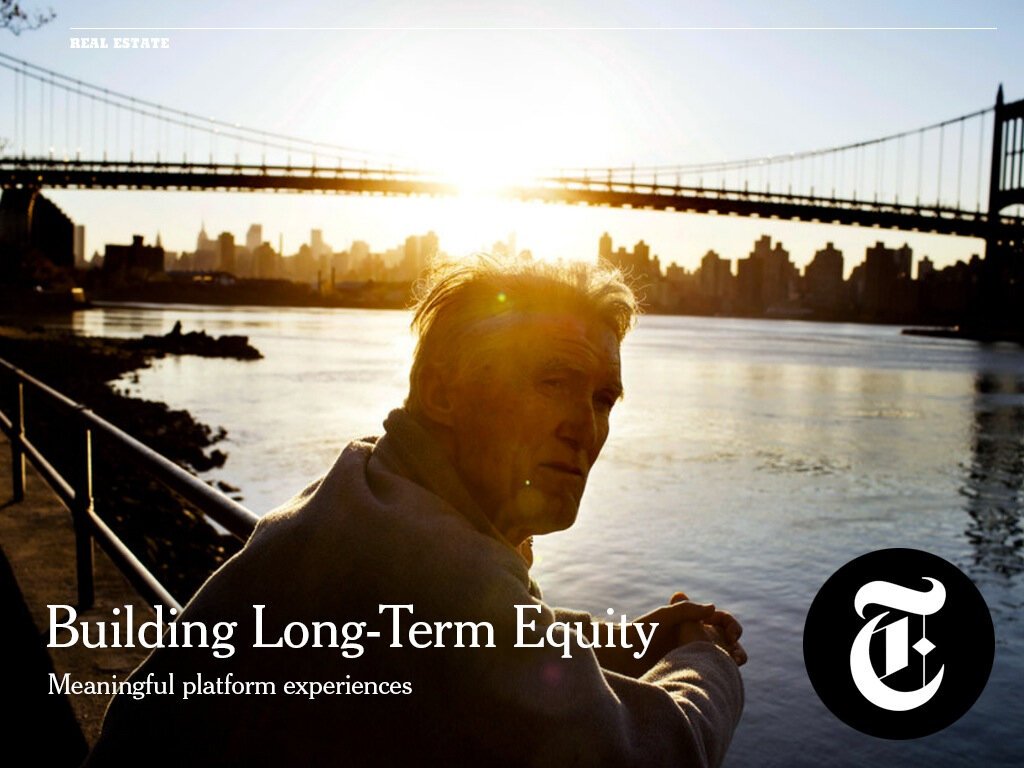The Slower Web
Data-driven insights as a strategy for growth
RETSO Real Estate Conference Keynote, Atlanta (2014)
Programming Note: This was the second time I’d spoken at RETSO, one of my favorite real estate conferences that’s unfortunately no more. I’d planned to attend the previous year, but fell ill, really ill, and had to follow along from my hospital bed online unfortunately. We didn’t know it was going to be the last RETSO, and I wish I’d made more of my experience there, although we did get to enjoy a great Braves game together at the stadium. I was relatively new to my role at The New York Times, and a lot of what I spoke about was starting to be informed by a life in the newsroom, as opposed to inside a brokerage.
Thank you so much to Brad and Team RETSO for inviting me today, and for those very kind words of introduction. I’m thrilled to be here representing The New York Times, and very grateful for the opportunity to share some of our digital real estate product, search and platform perspectives with you all. As some of you know, I wasn’t able to make RETSO last year. So being here, in every sense of the word, is very special for me.
Stories about people and their connection to place are at the heart of what we do at The New York Times, no more so than within the real estate section. So today, I’m going to share with you a series of short stories. And why’s that? Well, it’s because I believe that storytelling is at the heart of communities, families and cultures. It’s also at the heart of memories. It’s the most shareable type of content that has ever existed, on or offline.
And as a passionate advocate of real estate brands, products and building things to make the process more enjoyable, especially in New York, I believe it’s in the DNA of what it feels like to own a home.
So today I’m going to talk a little about how we approach an idea close to my heart. Something that’s often called The Slow Web. And if you’re interested in cultivating long-lasting readership, actual content engagement, and deep, considered, digital relationships, the slow web offers meaningful focus in a world driven beyond extreme distraction.
This pervasive climate of attention deficit has made it easier than ever to pretend to know so much without actually knowing anything at all. And if you work in an industry who’s value proposition is being heavily questioned by its own customers both young and old, this poses true risk. Indeed, the sense that through specialization, people are getting better and better at less and less, is very real. So much so that sometime soon it seems that everyone will be superb, at nothing.
Rebecca Blood puts it best when she says:
“The Slow Web would be more like a book, retaining many of the elements of the popular web, but unhurried, re-considered, additive. Research would no longer be restricted to rapid responders. Conclusions would be intentionally postponed until sufficiently noodled-with. Writers could budget sufficient dream-time before setting pixel to page. Fresh thinking would no longer have to happen in real-time.”
Over the past two centuries, we humans have had a industrial, technological love affair with speed and efficiency. This is no truer than within a news organization such as The New York Times. And of almost all industries, news is absolutely unforgiving when it comes to unscheduled diversion, and the modern need to report the news as quickly as possible has only accelerated in a stream-driven culture like the one in which we current exist.
Indeed, at The New York Times alone, we write the equivalent of a Harry Potter book and stream over 13,000 hours of video, every single day. For the RETSO robots amongst you who love these kinds of things, that’s like watching Star Wars back to back over 6,000 times.
And while it’s true that we’ve always been heavily invested in our relationship with time, the consequences of living in an accelerated digital culture where the world very often appears to many to be stuck in fast forward, are leading some to attempt to reclaim the word ‘slow’ as a positive value.
This is really at the heart of what we do in Real Estate at The Times, where longer form content, be it articles, slideshows, videos or even how we think about search is not just the norm, but an important part of our DNA. For example, there’s an enormous difference between ‘fast’ and ‘accurate’.Especially as we see time and again with every news event that breaks hard and fast on Twitter. The social responsibility and moral imperative to report the news in a courageous, accurate and fair manner runs deep within the DNA of The Times. Indeed, The New York Times’s core purpose is to enhance society by creating, collecting and distributing high-quality news, information and entertainment. And of course, these same issues of accuracy, speed and distribution are ones that will resonate well with those of you in the room today who are interested in real estate syndication conversations.
So, in an increasing world of ubiquitous ‘fast’, the notion of slowing down, savoring experiences, holding thoughtful discussion, and enjoying richer, more nuanced modes of thought in order to be more creative and productive, is itself swiftly becoming an unexpected premium. I believe this approach is actually closer to the inherently more thoughtful, slower and less impulsive customer journey of what it feels like to really buy a home. If speed and efficiency are everywhere, simply due to its economic scarcity, ‘slow’ begins to enter the realm of being a luxury commodity.
Under the guise of multitasking, a fast-paced, dynamic, exciting but ultimately time-starved environment often makes the simple act of listening much harder, and this has some serious implications for an industry such as ours which is built upon customer service and referrals. Conventional advice towards better listening, as beautifully articulated recently by Ram Charon in The Harvard Business Review, suggests that simply being “emotionally intelligent and available” (what some refer to as being ‘in the room’) is often the solution. It’s a tough modern challenge for many.
However, in a culture where shrinking attention spans, perpetual digital distractions and the white noise of media surround us at all times, this can often be a real problem. As Charon accurately suggests, listening opens the door to truly connecting, and is in fact the gateway to building relationships and opportunities. In many ways, it’s the cornerstone of customer service, and in the DNA of the expectation for what the best real estate professionals do.
But in an accelerated culture, that listening process can be all but eroded very very swiftly, often with the result that it’s much faster and appears to be more efficient, essentially providing a higher level of customer service by acting more proactively, if we move to make our decisions based on the information we already possess. At best this is dangerous decision making, as we often don’t have the information we really need when we do this.
Even listening has often begun to feel too passive, as if in many ways it’s the opposite of action. Some characterize this as simply waiting to talk. Slowing down and replaying the discussion can too often simply feel inefficient.Charon concludes that listening is a central competence for success, and that at its core, ‘listening IS connecting’.
The embrace of many social platforms suffers from this same problem of course. The bullish stride towards early adoption has seen many casualties, especially within the field of real estate marketing, to the extent that mass confusion is perpetuated by ill-conceived tactical, tip-based approaches, list-making and ultimately the never-ending questions surrounding the return on investment of these platforms for business. The real estate industry’s embrace (or non-embrace) of Google+ is a wonderfully chaotic example of this in everyday practice. The same could perhaps be said of the dying embrace of Facebook taking hold this year.
Nick Bilton, lead technology writer for The New York Times, writing in an article entitled ‘Today’s Technologies Need An Off-The-Hook’ Option’ describes the climate another way. He says:
“Technology created the problem. It’s time for technology to fix it. One thing’s for sure: Today’s communications, with its unlimited avenues and no traffic lights or stop signs, is broken. We need technological solutions that allow us to take our smartphones and computers off the hook, and not have anything waiting for us if we do.”
A utopian ideal perhaps, but a necessary one for many. Yet, as embraced as these social platforms continue to be, and as aggressively as their user numbers continue to grow, the act of truly listening remains a challenge for many online, to the extent that there’s an increasing sense of isolation fueled by the synthetic sense of virtual connection.
As Claude Fischer ominously suggests, for as connected and social as we are, we’re still behind a screen, and often alone.
This has caused many digital psychological and societal analysts to question if social technology is in fact creating an epidemic of loneliness. The topic of digital reclusiveness is a popular and timely one, and what many of them conclude is that it’s not a particularly modern problem. For example, tracing the history of cultural loneliness, Fischer continues that Federal policy makers in the 1950's were increasingly worried about the isolation of rural farm workers, and the rising suicide rate of immigrants separated by distance from their families.
Indeed, quoting the historian Page Smith, Fischer even traces this back to the ‘cosmic loneliness’ experienced by the early Colonial Americans in being separated from the familiarity of their European culture.
A 2006 Duke University study performed 2 general social surveys on this topic, concluding that the percentage of Americans who felt that they had no-one to confide in had tripled between 1985 and 2004. The report’s findings, post-publication were heavily questioned, notably by Fischer himself.
Sure, there might be fewer family dinners happening than 30 years ago, and we might be collectively entertaining fewer houseguests overall, but the idea of group eating and sociability has continued unchanged, it’s just happening outside of the house more often as mobility increases, and more localized options become available to wider groups of people.
This has interesting implications surrounding the nature of what we define as a home, and specifically the role of rooms within the home, with the kitchen now often being replaced by the living room, or otherwise room with the television or entertainment center in it as the modern hearth of the family. Instead of gathering around the dinner table, we’re increasingly gathering around ‘America’s Got Talent’.
And if that’s not working, the digital retreat into the conversation that’s happening outside the room, either on our smartphones or tablets, is often a practical, familiar and welcome alternative that we’re happy to accommodate, as we bathe in the digital glow of our devices. This is, of course, no more acute than during commercial breaks, and for marketers this poses a greater challenge beyond even the current climate of utter customer indifference.
Many question, especially for business purposes, if we are capable of sustaining meaningful, intimate ties (for example with past clients or prospects) online, and Sherry Turkle has provided some wonderful commentary that’s worth checking out, on the torturous self-doubt that results from online friendship.
And to paraphrase Stephen Marche, it’s certainly true that we’ve never been more detached from one another, or lonelier. We live in an accelerating contradiction. The more connected we become, the lonelier we are.
However, the problem isn’t necessarily with the platforms themselves. Just as the telephone and cars were seen as the original ‘technologies of sociability’, there’s a documented, often incorrectly assumptive pattern that introverts go online to avoid seeing people, whereas extroverts go online to see people more often, so it’s not Facebook or Twitter in particular, rather than the cultural and psychological changes they create.
This echoes much of what writer Susan Cain explores in her wonderful book ‘Quiet: The Power Of Introverts In A World That Can’t Stop Talking’, a beautifully articulated study on the power of introspection. The leading of a rich inner life, full of thought, reflection and creativity is often frowned upon by modern business culture, which promotes and celebrates the extrovert, the team player, the collaborator, the go-getter.
Cain argues passionately that some of the most important work performed in the fields of science, technology, marketing and even entertainment, has come from those who have been extreme introverts. And as Cain touches upon, but doesn’t dwell, there is an increasing housing trend of more people not only living alone, but deliberately choosing to do so. Those who live alone continue to lead rich, fulfilled social lives, they just do it outside of the environment of the home.
So, to pull this together, a climate of accelerated digital culture, fueled by increasing societal isolation, has led to the embryonic beginnings of what’s often referred to as The Slow Web. In many ways, the slow movement, across many different types of industries, originates with the slow food movement, in reaction to the all-consuming culture of fast food. Slow food essentially defines itself by what it’s not, and was sparked in reaction to McDonalds opening a restaurant in the beautiful Piazza di Spagna, otherwise known as The Spanish Steps, in Rome.
In one of the most comprehensive pieces concerning the Slow Web online, Jack Cheng sets the discussion in terms of a comparison. Whereas fast food is unhealthy, consisting of low-grade ingredients that are high in sugar, salt and fat, which are devoured quickly and often in industrial-sized volume, slow food derives from the feeling we get from food.
It’s about letting things marinate, home cooking, using aged ingredients, savoring the moment of eating them, and enjoying them socially. It’s about living in the moment, and making that moment last for as long as it needs to.
Consequently, the Slow Web describes the feeling we get when we consume certain web-enabled things. For many websites, particularly those within the real estate industry, the idea of ‘feeling’ anything at all other than terror and an overwhelming dread of torturously wading through thousands of search results is notably absent.
Many online are using the ideas of nostalgia (think Instagram), peace (think Calm.com) or even forced inactivity such as one of my favorites, DoNothingFor2Minutes.com, to slow down the current experience of digital consumption into a form that’s more timely, and ultimately more enjoyable. But for many, those 2 minutes feel like an agonizing eternity.
Jack Cheng continues his comparisons by asking “So what’s the Fast Web?
It’s the out of control web.
The oh my god there’s so much stuff and I can’t possibly keep up web.
It’s the spend two dozen times a day checking web.
The in one end and out the other web.
The web designed to appeal to the basest of our intellectual palettes.
The salt, sugar and fat of online content web.
It’s the scale hard and fast web.
The create a destination for billions of people web.
The you have two hundred and twenty six new updates web.
Keep up or be lost. Click me. Like me. Tweet me. Share me.
The Fast Web demands that you do things and do them now.
The Fast Web is a cruel wonderland of shiny, shiny things.”
So as Cheng suggests, the modern equivalent of the Fast Web, the cornerstone on which it is built, is ‘real-time’. So much so, that there are increasingly smaller gaps between experience and sharing. For many, a moment unshared is a moment that doesn’t truly happen in a meaningful way any more, and the response time of online customer service is often the deciding factor in a purchase decision.
Cheng characterizes the differences between the Slow and Fast Webs as those between real-time and timely.
The real-time web is chaotic, unstructured, and a firehose.
The Slow Web is timely, and predicated on the idea that things happen when and as you need them to happen. It’s more about serendipity than search. More about discovery, than results.
A wonderful example of the Slow Web is of course, Instapaper, built on the simple, beautiful idea of the deferred web.
It’s the ‘I really want to read this but don’t have time right now’ web.
It’s the ‘I will enjoy this on my schedule’ web.
And Cheng describes this experience as “an activity that would otherwise be impractical can now carry on in a manner more timely for each participant”. It’s not the ‘do this now’ web so prevalent in online click bait, which has no sense of rhythm. It’s inherently random and chaotic, unstructured and unthinking, and dangerously unmoderated in its advice to those working in a struggling economic climate.
Rhythm is an important but highly undervalued productivity tool, as an expression of moderation, and one of the key culprits of unmoderated digital experiences are, of course, our inboxes. Many modern productivity tools are about standardizing interactions, whereby everyone gets a homogenized, but immediate response.
This approach, as Cheng continues, is destination-based. It’s about the tools and how to use them quickly and most efficiently.
The Slow Web is inherently interaction-based.
It’s about how the recipient feels upon your note arriving in their inbox. It’s not about how quickly you responded, it’s about the quality of how you responded. Simply put, it’s the creation of memorable, meaningful, thoughtful digital experiences that deliver truly exceptional customer service. Getting a quick answer often means that you’re getting the wrong answer. We see this echoed in the accuracy of breaking news on Twitter every day of course.
The Slow Web isn’t about homepages, search, inboxes and dashboards. It’s about the right information, in the right person’s hands, at the right time.Cheng uses the word ‘timeliness’ in describing this, an accurate word for a world already filled with notifications. It’s the right updates, in the right place, delivered when you need them, not when they are created, and that’s an important difference in slowing the web down to make it more digestible for our customers in particular.
Cheng talks at length about the core ideas of the Slow Web being built upon effectiveness.
The Fast Web is built upon page views, scaling and serving the needs and desires of advertisers.
The Slow Web is built upon insight, knowledge and learning.
Cheng advocates a strong strategy of effectiveness before growth, and using the ideas of content timeliness, rhythm and moderation to truly build trust and brand equity in the mind of the customer.
He advocates:
“Behavior change, not growth.
Behavior change is about improving the lives of others, scale is about ego.
Getting scale after nailing behavior change is easier than nailing behavior change (and thus having a shot at durability) after hitting scale.”
Cheng’s remarks will resonate well with anyone who is a regular reader of the tip-centric social marketing platform advice given to real estate professionals. Ramping up a presence — getting content viewed, growing a footprint, and connecting at scale are items that recur frequently in the posts and articles that appear daily in our Twitter feeds.
Almost all of them are diametrically opposed to the fundamental Slow Web ideology of improving other people’s lives, one of the core tenets of the real estate industry.
So Cheng concludes ultimately with a discussion of value. The Slow Web unlocks value from deep within the past — it’s really closer to how a researcher works with an archive of information. It’s a process which imparts unexpected discovery, memorable experiences, and powerful emotional connections.
Therefore, curating, collating and synthesizing the vast archive with what Rebecca Blood wonderfully terms ‘measured deliberation’ allows us to return to ideas and revisit them in ways that the Fast Web simply forbids or refuses to facilitate.
It affords us fresh perspective, and to shed light on otherwise overlooked connections. It allows us to perform a higher level of customer service, and separate ourselves from the competitive herd.
This has also created some unexpected, magical new forms of entertainment. For example, earlier this year, one of the main French television networks broadcast a 9 hour program, ‘Tokyo Reverse’ of a man walking backwards through the streets of Tokyo. The concept has been called Slow TV and is being hailed as a ‘small revolution’ for European viewers. Slow TV is a genre of marathon programming in which an ordinary event is filmed, often live, in its entirety. In Norway, more than half the country tuned in to watch a six-day ferry journey through the fjords. A burning log fire and knitting were previous Slow TV subjects — and anyone who enjoys The Yule Log Channel on Christmas Day will know what I’m talking about here. Fans say it gives viewers a chance to get deeply interested in details which might otherwise be missed in a world all about speed. Ironically perhaps, these events have proven to be enormous hits on social media platforms.
There’s strong evidence to suggest that the oxytocin-fueled Fast Web of perpetual notifications is taking a collective toll on our health, diets, work, communities, memories and relationships. It devalues the true meaning of friendship and undoes the real work necessary to build lasting connections.
Many larger corporate organizations are now finding this to be a serious human resources issue, to the extent that IBM recently launched a ‘slow email’ initiative internally in efforts to allow their staffers to slow down, be more productive, and genuinely think about the business problems they were tasked with.
But as Nick Bilton concedes: “Sure, you can turn off your smartphone when you want some alone time, but when it’s turned back on, like the grand finale of a fireworks show, the phone will boing, chime, trill, marimba, and vibrate erratically with text messages, voice mail, app notifications, e-mails, and a cannonade of messages from all the social networks you’re connected to.”
That dreaded feeling of returning from vacation to a full inbox, and spending the first few days endlessly wading through everything that needs to be responded to or followed-up on is something many of us have experienced. Indeed, there’s compelling neurological evidence to suggest that taking an e-mail vacation, or putting yourself on a Slow Web diet significantly reduces stress levels, as we no longer submit to the tyranny of the digital alert. As a first step, Gmail is currently considering a snooze button.
And as Nick Bilton continues to speculate, the notion of technology beginning to address its own shortcomings might be something we’ll get to see a lot more of in the future. For as digitally connected as we’ve allowed ourselves to become, there’s an increasing need for an off switch, free of consequence.
This is a call to action for more of the Slow Web ideals to be used in the real estate industry, but don’t get confused. Responsiveness and the Fast Web are still important, and have their place in our business.
It’s not about being lazy, it’s about doing the right things at the right time, and creating amazing experiences for your customers around that idea, for them.
It’s about building wonderful, slower, differentiated things that took time and investment, and thought, and energy over a long time to develop.
It’s about the long-term equity of meaningful platform experiences. Pace and speed are critical.
And perhaps most importantly, it’s about timeliness, rhythm and moderation. This is truly how to separate yourself from your competition, do it in a dynamic way, and allow yourself to have some fun at the same time.
I hope you enjoyed my stories.
Thank you.


























































